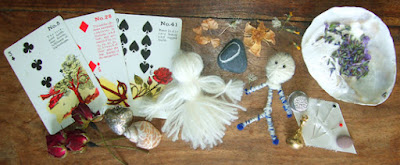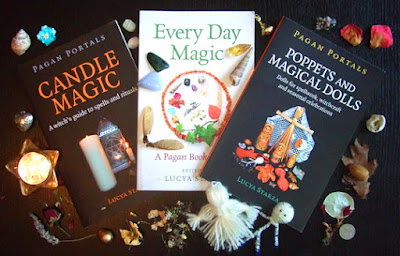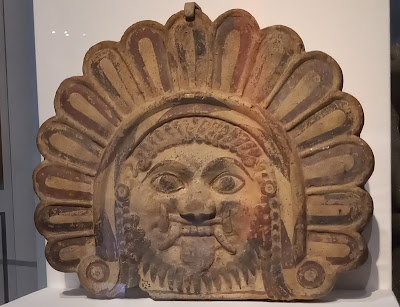Friday, 30 September 2022
A Sussex Heritage Walk & an Anglo-Saxon Burial Site
Thursday, 29 September 2022
Long Burgh Long Barrow - Ancient Guardian of Alfriston
The Ancient Guardian of Alfriston is how this prehistoric monument is described on the sign at the site. Long Burgh Long Barrow is high in the South Downs overlooking the Cuckmere Valley and the village of Alfriston in Sussex. It was built in the Early Neolithic period as a funerary site and can still be made out as an earth mound higher than the ground around it. A chalk path skirts the mound at itsnorth-east end.
I took the photo above when I was walking part of the South Downs Way yesterday. Nearby Alfriston is also home to the Sussex Faerie Festival each year.
Have you visited any sacred sites this year? If you'd like to share a picture you took on A Bad Witch's Blog, let me know as I'm happy to share photos. If you want to send me a photo for a post, please email it to badwitch1234@gmail.com Let me know what the photo shows and whether you want your name mentioned or not. For copyright reasons, the photo must be one you have taken yourself.
Links and previous related posts
https://historicengland.org.uk/listing/the-list/list-entry/1012923?section=official-list-entry
http://www.badwitch.co.uk/2022/09/pagan-eye-avebury-stone-circle-on.html
http://www.badwitch.co.uk/2012/07/pagan-eye-silbury-hill-on-summers-day.html
http://www.badwitch.co.uk/2013/09/necropolis-pictures-from-stoney.html
Wednesday, 28 September 2022
Magical Online & London Events in the Next Weeks
Here's a list of weird, wonderful and witchy events over the next week or so with a mixture of online and in-person things to do. I generally list events in the UK, especially in or near London, but some are outside that time zone. If you know an online or London-based event you want included, please email badwitch1234@gmail.com
Now to 6 January 2023; Wicked Spirits? Witchcraft and Magic. Exhibition at Colchester Castle, Essex, CO1 1TJ. The Museum is also running some after-hours events including Magic and Folklore with Simon Costin of the Museum of British Folklore on 6 October from 5pm-7pm. https://colchester.cimuseums.org.uk/wickedspirits/51.582208, -0.141830 at 5pm. Tickets free but you must reserve a place. https://www.meetup.com/LondonWoodlandWitches/
Tuesday, 27 September 2022
Pagan Eye: A Crow on a Dead Tree in Richmond Park
http://www.badwitch.co.uk/2021/03/pagan-eye-buzzard-perched-in-bare-tree.html
http://www.badwitch.co.uk/2013/04/pagan-eye-grey-heron-in-park.html
http://www.badwitch.co.uk/2022/06/pagan-eye-young-fox-resting-in-ivy.html
http://www.badwitch.co.uk/2022/08/pagan-eye-reynard-junior-young-fox.html
Monday, 26 September 2022
Review: The Golden Bubble - Magical Development
For anyone running a pagan group - or thinking of starting one - there's a new book out that I thoroughly recommend. The Golden Bubble: Magical and Personal Development Through Pagan Group Practice is a wonderful compendium of visualisations, pathworkings, wheel-of-the-year rituals and other practical magical work created by Jean Williams and her group at Pagan Pathfinders over several decades. It represents years of material, ready to use. However, it's a lot more than just that.
The book's editor and contributor, Liz Wigglesworth, explains more about its background and what it contains:
"Jean Williams held Pagan Pathfinders in the living room of her London home almost every Monday night for over 30 years. Conceived as a group for pagan seekers, it evolved into so much more than that. Using her background in psychology and her interest in the human potential movement, she guided many earnest seekers through meditations, group work and ritual. The aim was to learn about ourselves, each other and the magical world around us. The group successfully helped many people to develop their interest in a nature-based spirituality and to expand their minds and utilise their own potential. It also created lasting friendships and wonderful memories.
"This book aims to pass on those techniques, as well as explaining some of the psychological theories behind them. It is hoped others will be inspired to run such groups and provides the basic tool kit for doing so. It is a valuable resource in a time when more and more people are yearning to rekindle their connection with nature and with each other through shared seasonal celebrations."
Jean's background was in humanistic psychology as well as in a variety of esoteric techniques including those of modern pagan witchcraft. Pagan Pathfinders was open to pagans and seekers of all paths and traditions. What I found refreshing from reading the book was that there was no requirement or pressure to believe in gods and goddesses as actual beings - it was perfectly acceptable to view them as psychological archetypes in the Jungian sense.
That humanistic view appears to have been Jean's personal perspective and one that resonates with my own - although I call myself an agnostic pagan. I respect people's personal experiences when they say they have encountered deities, but I also respect the view that there is at this time no scientific proof they exist. Essentially, it doesn't matter - the workings described in The Golden Bubble are designed so that both athiests and theists can take part as a shared personal development experience.
The name of the book comes from a guided visualisation that was a core exercise for Pagan Pathfinders, and is described in detail in the prologue. It involves relaxing and imagining yourself surrounded by a bubble of golden light. You then imagine that light infusing your body, cleansing and energising you. It was seen as a foundation for the spiritual and mental disciplines practiced by the group. I think it's also an apt term for the experiences of those people who attended Pagan Pathfinders over the decades. The afterword includes the testimonies of some of them, and they all say it was a wonderful community in which everyone felt welcome. I believe that's what all pagan groups should be like.
The Golden Bubble: Magical and Personal Development Through Pagan Group Practice is published through Lulu and has an RRP of £17. You can find it here: https://www.lulu.com/shop/liz-wigglesworth-and-jean-williams-and-ruth-bayer/the-golden-bubble/paperback/product-g5mwey.html?
It can also be found on Amazon.
Saturday, 24 September 2022
My Talks & Workshops: Candle Magic, Poppets, Scrying
Friday, 23 September 2022
An Equinox Tarot Card: Mourning or Seven of Vessels
The meaning given in the book that comes with the set is this:
"This is a time to honour what is dead and mourn for what has gone. Learn the lessons of letting go by offering thanks for cherished memories and being at peace with the past."
In analysing readings where this card appears, the book points out that mourning begins the process of recovery after failure or bereavement. We should allow our emotions to flow with their natural course and recognise that it can take a lot of time after a loss to get a sense of closure and be at peace.
Sometimes we don't realise what was important to us until it is gone. A lot has happened in the world over the past few years. Many are still mourning personal losses as well as feeling sadness over things that have fallen into history. The Autumn Equinox is the point in the year when the nights start to become longer than the days. We are entering the time of festivals to honour the dead. The message of this card is to allow yourself to mourn if you feel you need to, and to allow others to mourn for as much time as that will take.
In Rider-Waite-Smith style tarot decks, this card corresponds with the Seven of Cups, but the meaning is a bit different from the card I drew. Images show cups filled with possible gifts that the future might hold, some are beneficial, some are harmful, and they are all potentially just illusions. They represent emotional choices we face as we go forward in our lives. The message is to try to see through illusions and to pick wisely.
You can read my review of the Wildwood Tarot here.
Previous related posts
http://www.badwitch.co.uk/2014/09/are-some-tarot-decks-more-genuine-than.html
http://www.badwitch.co.uk/2019/05/the-wildwood-tarot-stag-card-strength.html
http://www.badwitch.co.uk/2021/07/divination-blasted-oak-from-wildwood.html
http://www.badwitch.co.uk/2022/09/a-poem-on-learning-of-death-of-queen.htm
Thursday, 22 September 2022
Organising Goddesses: Harder than Herding Cats...
In the past, before the 1960s, scholars tended to be men, and tended to interpret Goddesses as being related to fertility, even if it was a stretch to do so. For example, Robert Graves, in his book The Greek Myths which was published in 1955, wrote:
“The moon’s three phases of new, full, and old recalled the matriarch’s three phases of maiden, nymph (nubile woman), and crone. Then, since the sun’s annual course similarly recalled the rise and decline of her physical powers – spring a maiden, summer a nymph, winter a crone – the Goddess became identified with seasonal changes in animal and plant life; and thus with Mother Earth who, at the beginning of the vegetative year, produces only leaves and buds, then flowers and fruits, and at last ceases to bear.”
While many women have found it empowering to think of Goddesses in terms of maidens, mothers and crones, it doesn’t work for all. Personally, as someone who went through life without becoming a mother and am now old enough to be a crone but don’t particularly like to be called one, I prefer to look for other ways of perceiving feminine power.
The British Museum’s Feminine Power exhibition organises powerful female figures into five themes: creation and nature; passion and desire; magic and malice; justice and defence; and compassion, wisdom and salvation. The author of the exhibition catalogue, museum curator Belinda Crerar, explains: "Together, they show how feminine influence has been conceived in a phenomenal range of human experience.” Here’s an example in each of those categories from the exhibition and its catalogue.
Creation and Nature: This includes deities who gave birth to the world or to countries as well as those who are strongly associated with the land, sea, and all things growing including harvests. In the oldest Hindu texts, the Vedas, there are hymns to Prithvi (prith-vee), Goddess of the earth, creator of the world, and source of nourishment. The Vedic Goddess Shri is the embodiment of prosperity, royal power and beauty. Shri is known as Lakshmi in modern Hinduism and is associated with wealth, success and good fortune. To the right you can see a photo I took of her statue in the exhibition
Passion and Desire: Aphrodite was the Ancient Greek Goddess of grace, beauty and fecundity. She’s often thought of as a love Goddess, but is more than that. Her Roman equivalent is Venus. Both were considered important for martial success as well as in romantic situations. You can read more on my earlier blog post about her.
Magic and Malice: Medusa of Greek and Roman mythology, although often depicted as a monster, has also been portrayed as a victim, a metaphor for unrest, and a figurehead for feminist rage. At the top you can see a photo I took of her statue in the exhibition. Hekate stood at the crossroads between life and death for the Ancient Greeks and Romans, but is also protective and associated with witchcraft and magic. You can read more on my earlier blog post about her.
Justice and Defence: The Greek Goddess Athena embodied military strength; civic governance through justice; economic growth through industry; and art, philosophy and science. To the right you can see a photo I took of her statue in the exhibition.
Compassion and Salvation: In Buddhism, Bodhisattva are enlightened beings who guide others on their spiritual journeys. In some forms of Buddhism the Bodhisattva of Compassion is variously known as Avalokiteshvara (ava-low-key-tesh-vara), Guanyin, and Kannon, meaning Perceiver of sounds. She hears the cries of those who are suffering. I blogged about Guanyin earlier this week.
There are many other ways of thinking about the themes goddesses represent in general terms and I’ll be writing more on the topic of organising goddesses in the future. There's also a few more days to go and see the Feminine Power exhibition before it closes on September 25th. I thoroughly recommend it if you are in London and haven't seen it already.
I also in the past contributed to a book called Naming the Goddess, published by Moon Books. You can also find an extract from that here: http://www.badwitch.co.uk/2014/09/extract-naming-goddess-eris.html
You can view the exhibition catalogue for Feminine Power on Amazon
Other previous related posts
http://www.badwitch.co.uk/2022/05/launch-party-pics-feminine-power-at.html
http://www.badwitch.co.uk/2022/07/pagan-eye-sheela-na-gig-at-feminine.html
http://www.badwitch.co.uk/2022/06/book-review-feminine-power-exhibition.html
http://www.badwitch.co.uk/2022/07/altars-british-museum-goddess-day-focus.html
Wednesday, 21 September 2022
Autumn Equinox Events in & Near London & Online
The Autumn Equinox, when the day and night are in balance, is on Friday September 23. Celebrations are taking place over the next week or so. Here's a listing of pagan and witchy events in or near London, because that's where I live, but I also a few festivals further afield and plenty of things online that you can enjoy anywhere.
51.582208, -0.141830 at 5pm. Tickets free but you must reserve a place. https://www.meetup.com/LondonWoodlandWitches/
Please note: I am not responsible for any of these events except my candle magic and poppet workshops at London Month of the Dead. I try to make sure all details are correct, but contact the organisers of any event you are interested in for more information before turning up. If you know of something you want listed, please email the details to me at badwitch1234@gmail.com.







.jpg)





.jpg)



.JPG)



.jpg)

.jpg)















.jpg)



.JPG)



.jpg)


